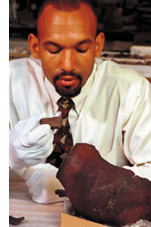|
|
 Grad
Student Leads Excavation Of Black Seminole Town
by Cathy Keen
Grad
Student Leads Excavation Of Black Seminole Town
by Cathy Keen The first-ever excavation
of a black Seminole town is under way
in central Florida and may reveal how the runaway slaves actually lived
within the embattled Seminole Indian nation, says a University of Florida
graduate student who is leading the excavation.
Called "Maroons," a term derived from the Spanish word "cimarrones,"
meaning fugitive, they fled from Georgia and South Carolina to Florida,
where some of them escaped pursuing authorities to befriend and live with
the Seminole Indians.
"No one has actually identified one of their towns on the ground
until now," said Jerald Milanich, a UF archaeologist and member of
the excavation team. "Although we know something about the black
Seminoles from documents, here is an opportunity to physically learn whether
their lives were similar to what they were like earlier in the slave quarters
of Southern plantations or if they developed a unique lifestyle that emerged
with their new status as free people in Florida."
They established "Abraham's Old Town," or Peliklikaha, about
10 miles east of Sumter County's Dade Battlefield. That's where blacks
and Seminoles annihilated a U.S. Army force in one of the most decisive
battles of the Second Seminole War of 1835-42, said Terrance Weik, a UF
anthropology graduate student and the team's leader.
A powerful black Seminole leader, Abraham served as an interpreter for
Seminole Indian chief Micanopy during the critical war years, eventually
surrendering and helping the U.S. military to negotiate an end to the
war. That paved the way for Florida to enter the union, he said.
The UF team hopes to find out if the black Indians were subservient to
the Seminole Indians or if the blacks' military and interpreting skills
made them "masters of the Seminole" as some military documents
of the 1830s suggest, Weik said. Or they may learn that neither of these
scenarios is correct, he added.
"This is, in a sense, the next chapter after Fort Mose in the story
of African-American resistance to slavery in Florida," he said. "The
project will bring to light details of life, the everyday struggles and
the cultural heritage of this under-recognized group, and help us better
understand the early interactions between Africans, Seminoles and Europeans
on the Florida frontier."
The excavators also want to learn about the people's housing, what they
ate and if their pottery more closely resembled that of the Seminole Indians
or what they once made on slave plantations, Milanich said.
"Recently, there's been a lot of interest in Florida's black Seminoles,"
he said. "Historians and anthropologists have studied them, but they
haven't been looked at by archaeologists."
Like Seminole Indian sites, black Seminole sites are hard to find because
they are so ephemeral; they weren't occupied long, he said.
Black Seminoles left no written records, and while historical documents
describe things such as laws against Maroons and the military forces used
to hunt them, little attention has been paid to who these people were
or what shaped their material culture, Weik said.
"I think archaeology can say something more than what history has
said," he said. "History says who the leaders were or what crops
were produced. It doesn't go into how the villages were organized, what
the people got through trade or what their relationships were with the
Seminole Indians."
Archaeologists plan to pass on what they learn to public school children.
With grant funding from the Florida Department of State Division of Historical
Resources, the research team plans to hold public lectures and prepare
a brochure about the site that will be distributed to Florida schools,
museums and tourist agencies, Weik said.
"Our field work also will provide knowledge that we can use to help
find other black Seminole sites and to manage them so they become learning
tools for future generations," Milanich said.
Terrance Weik t366y@ufl.edu